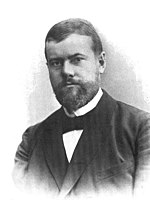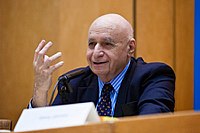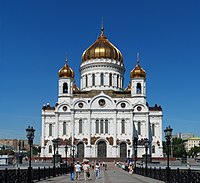Desecularization

Proponents of the theory of desecularization point to examples such as the
Pippa Norris and Ronald Inglehart argue that it is both true that (1) "virtually all advanced industrial societies" have become more secular in recent decades, but also that (2) people with religious beliefs represent a growing share of the world population, due to the higher fertility rate in poorer countries and among religious believers.[1] Vyacheslav Karpov states that secularization and desecularization are not mutually exclusive, but rather involve an interplay between the two phenomena.[2]
Secularization theories

Many scholars of the 19th century posited that the world was undergoing a process of
Demand-side and supply-side theories
According to Norris and Ingelhart, the traditional view of 19th century secularization can be divided into two perspectives: demand-side theories and supply-side theories. They take the view that "although the original theory of secularization was flawed in certain regards, it was correct in the demand-side perspective".[1]
Demand-side theories assert that secularization occurs "bottom up," such that as a whole, the general population will become increasingly rational independent of any influence from the secular government or religious leadership body.[1]
Examples of demand-side theories can be found in the accounts given by Weber and Durkheim. Whilst Weber rarely used the term "secularization," he is generally given credit for alluding to the idea that religion was gradually losing its prominence in society.[7] According to Weber, the world was initially seen as unified, with religion, politics and economics all existing on the same social plane. Thus the term "religion" was not necessary nor was it widely used because religion was included in all aspects of life.[8] According to Weber, when different aspects of society such as politics and economics were severed from religion, the demise of religion in the public sphere became inevitable.
Supply-side theories of secularization argue that the demand for religion exerted by the general population remains constant. This means that any change in the religious landscape occurs as a result of the manipulation of the "supply market" by religious leaders.[1] The construction therefore views the phenomenon as 'top down' development. Steve Bruce argues that the "supply" of religion is greatest when there is a "free" and "competitive" market for "providers" of religion, as in most Western nations, as opposed to states where one religion predominates.[9]
Desecularization theories
Terminology and definition

The term desecularization appears in the title of Peter L. Berger's seminal 1999 book The Desecularization of the World: Resurgent Religion and World Politics. According to Karpov, the term has received little analysis in the field of sociology,[10] however this section will refer to at least one significant development in the term's definition since its first use.
In that book, Berger argued that secularization theory has been "falsified",[11] though in a 2015 article said that it "was not completely mistaken".[12] He acknowledges that his original use of the term, referring merely to "the continuing strong presence of religion in the modern world", was "a bit sloppy".[12] Karpov has since developed the definition of the term, which Berger subsequently affirmed. Karpov defines the term as referring to a phenomenon that is counter-secularization and thus is reactionary to a prior period of secularism.[13] He states that desecularization can be defined as "the growth of religion's societal influence," but only if it develops in response to "previously secularizing trends."[10] Therefore, Karpov's development of the term essentially limited the definition to instances where religion was actively re-established as opposed to simply a state of continuity.[12]
Methodological concerns
Some scholars raise the issue of evidence. Vyacheslav Karpov for example, mounts a discussion on the different analytics that can be used in providing evidence for desecularizing trends.[14] He divides these analytics into two different types of evidence, (1) societal-level data or "macro-data" and (2) non-societal data, named in Karpov's article as "mega data." Macro-data deals with evidence obtained from individual societal "units." These units cannot exclusively be referred to as countries or nation-states because sometimes they can represent smaller sections, i.e. racial groups. Other data ("mega-data") is less objective according to Karpov, because it often refers to trends in more abstract terms such as in "modern society" or civilization generally.[14] Essentially, mega-data attempts to identify patterns on a more cosmic or global scale, whereas macro data can be very specific to nations, cities and racial groups such as church attendance and census results.
Because the term "desecularization" has been used to describe a global trend,[3] the question raised by Karpov is whether macro-data analytics can be considered as valid when they indicate specific trends in "societal units," rather than global trends.[14] There are two primary critiques of macro analytics: (1) that it leads to "methodological nationalism," causing a fixation on nation-states rather than broader civilization.[15] The next argument is that of (2) temporal limitation – the concern that because our current concept of "society" is relatively recent, a focus on societal-level analytics (macro data) restricts sociological analysis to modernity and no other time period. According to Karpov this poses an issue when considering religions with ancient historical trajectories.[14]
Karpov also cites several implications that result from using "mega" analytics, overall suggesting that it can allow for an understanding of desecularization that is rooted both in its historical trajectory, and its presence in modernity.[14] He concludes that whilst "macro" data can limit the analysis of desecularization, it can be compounded and used in conjunction with "mega" analytics to give sociologists a clear overall picture of a religious trend.
Examples
The Center for the Study of Global Christianity at Gordon–Conwell Theological Seminary estimated that the number of atheists and agnostics increased from just 3.25 million worldwide in 1900 to 798 million in 2000.[16] Sociologist Phil Zuckerman's studies on atheism have indicated that the atheist share of global population may be in decline, but that it is hard to predict future trends due rapid secularisation in rich countries existing alongside higher birth rates in religious countries.[17] In their 2015 article The Future of World Religions: Population Growth Projections, 2010-2050, Pew Research Center predicted that the religiously unaffiliated (atheists, agnostics and other people who do not affiliate with any religion) could decrease from 16.4% of the world population in 2010, to 13.2% by 2050, despite increasing in countries such as the United States and France.[18] The Center for the Study of Global Christianity predicted that the absolute number of atheists and agnostics would decline slightly between the years of 2019 and 2050, from 839 million to 828 million, while the number of religious believers would increase from 6.9 billion to 8.9 billion.[16]
Eric Kaufmann, whose academic specialization is how demography affects irreligion/religion/politics, wrote in 2012:
In my book, Shall the Religious Inherit the Earth?: Demography and Politics in the Twenty-First Century, I argue that 97% of the world's population growth is taking place in the
developing world, where 95% of people are religious. On the other hand, the secularglobal South and the aging, secular global North will peak around 2050. In the coming decades, the developed world's demand for workers to pay its pensions and work in its service sector will soar alongside the booming supply of young people in the third world. Ergo, we can expect significant immigration to the secular West which will import religious revival on the back of ethnic change. In addition, those with religious beliefs tend to have higher birth rates than the secular population, with fundamentalists having far larger families. The epicentre of these trends will be in immigration gateway cities like New York (a third white), Amsterdam (half Dutch), Los Angeles (28% white), and London, 45% white British.[19]
United States
Roger Finke and Rodney Stark state that church adherence in the U.S. increased from 1776 to 2000, from an estimated 17% to 62% of the population.[20] According to Gallup, church membership subsequently decreased to 47% by 2020.[21] Belief in God decreased from 98% in 1967, to 81% in 2023. For those aged 18-29, it was 68%.[22] According to Pew Research Center, the share of Americans not religiously affiliated increased from 16% in 2007 to 28% in 2023.[23]
Finke and Stark argue that the religious landscape in the 20th and 21st centuries only appear to be fading in significance because traditional routes of religious worship are being replaced by new wave religiosity.[20] They claim that populations in the modern world are moving away from traditional or established denominations such as Catholicism and participating in religious affairs in a more individualized sense.[20] For example, they argue that the colonial period was not as religious as once thought, using church membership as an indicator of religiosity. Instead they suggest that the onset of globalization and religious pluralism is responsible for a higher proportion of church involvement when compared with the monolithic, traditional histories of the mainstream churches.[24][failed verification]
Russia

Christopher Marsh explains the secularization in Russia before the collapse of the Soviet Union, stating that the regime was underscored by "scientific atheism," which was ultimately manifested in the persecution of religious clergy in Russia throughout the duration of the regime.[25] This secularization was indicated in the surveys conducted between 1981 and 1990, that showed a sharp decline in religious and supernatural beliefs, particularly in young people.[26] In Lambert's study, 12 variables were used in the survey to denote religiosity, which included propensity to pray, belief in an afterlife, etc. Furthermore, in a study conducted by Evans and Northmore-Ball, 80 percent of individuals claimed to be Russian Orthodox in 2007, with only half of the population doing the same in 1993, immediately after the collapse of the Soviet Union.[27] Both Berger and Karpov use this evidence to bolster their accounts of desecularization in the present.[14][12]
A large number of missionaries presently operating in Russia are from Protestant denominations.[28] According to a survey conducted at the end of 2013, 2% of surveyed Russians identify as Protestants or another branch of Christianity.[29]
Muslim world
Polling by Arab Barometer indicated that the share of the Arab world who said they were not religious increased from 8% in 2013 to 13% in 2019. The largest increases were in Tunisia and Libya, and the irreligious share decreased in Yemen.[30][31] Between 2012 and 2022, they also recorded an increase in the share who believe that religious clerics should influence government decisions. The highest figures were in Iraq (54%) and Jordan (49%), and lower in Lebanon (22%) and Egypt (20%).[32]
